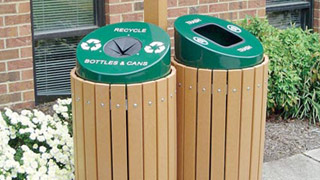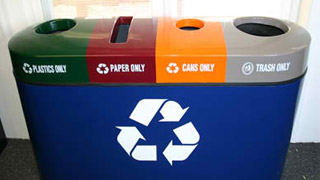Resources

How to Set up a Recycling Program for your School
Step 1: Consult a Waste Collection Service
Before introducing a program determine what type of recycling is possible for the area. Contact local businesses and find out who collects waste and recyclables in the area. When contacting the companies evaluate their customer satisfaction and collection costs, as well as, determine if neighboring businesses are interested in sharing recycling services.
Each community has a different procedure for collecting recyclables. Find out from the waste hauler what the collection requirements are in the area including:
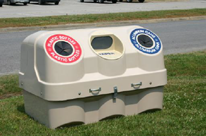
- What types of materials are collected
- How materials are separated
- What color schemes are used
- What types of containers are accepted
- When are materials collected
- How much does it cost
- What type of areas work with the collection trucks
- What happens when the program requirements change
Step 2: Determine What Is Needed
Determine how much and what type of waste will be generated by the school. Apply it to the specifications provided by the hauler and the anticipated level of traffic for the area. Together this information will provide what is needed for the recycling program to run. For example, a school environment may require desk side recycling bins or large capacity centralized collection containers. The type of recycling bin which will work best will depend on how often it will be emptied, the amount of employees contributing to it, possible janitorial services and the size of the area.
A great way to determine what is needed for a recycling program is by seeking the input and approval of those in the space. Applying the advice of others can encourage future program use. It can also ensure that an appropriate recycling program is selected by those who will be using it.
Step 3: Gather Recycling Equipment
Now that the specific needs of the program have been determined the equipment can be purchased. Consult a recycling bin manufacturer for program ideas and container solutions. Ensure that the bins selected are easy to use, efficient and environmentally sound.
Containers should feature the correct combination of visual indicators and sorting mechanisms to maximize the ease in use. Use clearly marked labels, shaped deposit slots and different color options. These tools will allow employees to quickly identify what the bin is designed to collect.
Implementing plastic containers which are environmentally sound can assist a recycling program. Select containers which are 100% recyclable, made with a minimum of 35% recycled content and complimented by matching waste baskets. Containers meeting these requirements will maximize the results of an office recycling program as they have green solutions built right in.
North American made containers have a reduced impact on the environment. Local products will reduce air pollution resulting from overseas shipping and toxins from foreign containers. Also, if the recycling bins are within arm’s reach they will be easier to replace or distribute in the future should new containers be needed.



Step 4: Organize the Recycling Program
After a container is selected it must be incorporated into a well organized recycling program. The first step is assigning a program coordinator. This should be someone in the school who is interested in taking charge of the program. Once the coordinator is made aware of their responsibilities they can ensure that the recycling program is always running smoothly.
The new candidate can begin their duties by selecting where the containers should go. When deciding where bins should be placed bear in mind other containers which may be in the environment, traffic, capacity and collection. The scheduling of container collection may be the deciding factor in determining where the bins should go. Placement options may be limited depending on the size of the collection vehicle and the accessibility of the area.
Step 5: Roll Out Program
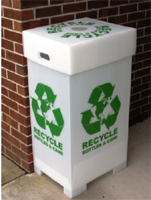
Following the development of a recycling program is the execution. In order for the program to run smoothly the end user must be educated on how it operates and understand what the goals are. Rolling out the initiative will get those sharing the space excited about the program and motivated to use it.
Organize a meeting to roll out a recycling program at the school. Distribute promotional materials, such as, miniature recycling containers filled with program goals and contact information. The goals should include current and projected statistics for the recycling program. The contact information should include the name, location and description of responsibilities of the program coordinator. Throughout the meeting encourage staff to discuss the program and interact with the coordinator. This will allow others to offer suggestions for improvement.

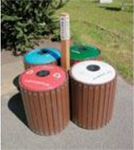
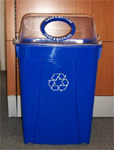
Step 6: Maintain Program
Maintaining a recycling program is a critical component to ensuring its longevity and success. A large part of the upkeep process will be the responsibility of the program coordinator. They will need to constantly monitor the effectiveness of the program and find ways to improve it. The coordinator will also be responsible for keeping those in the facility enthused and new employees educated on the program procedures.
There are several ways a program coordinator can keep up enthusiasm within the school. For example, a record of the amount of recyclables leaving the facility can be stored and statistics can be generated on the materials recovered. These statistics can be presented to students monthly with program update awards congratulating them on a job well done. This will positively recognize the efforts of the staff and students and encourage them to continue to keep recycling in the future.



































